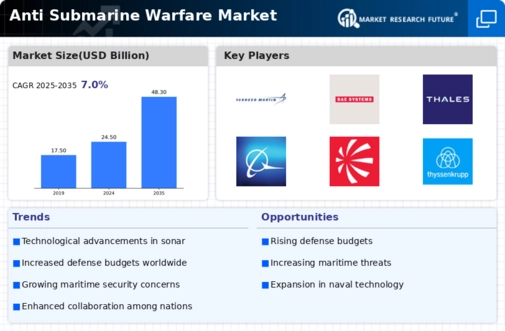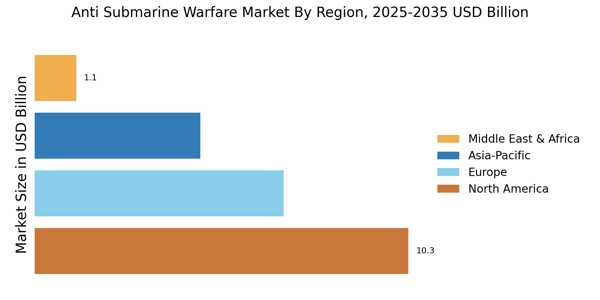Technological Innovations
Technological advancements play a pivotal role in shaping the Anti Submarine Warfare Market. Innovations in sonar systems, unmanned underwater vehicles, and advanced data analytics are revolutionizing the way navies detect and neutralize submarine threats. The integration of artificial intelligence and machine learning into anti-submarine warfare systems enhances operational efficiency and decision-making processes. For instance, the development of next-generation sonar systems has improved detection ranges and accuracy, allowing for more effective tracking of submarines. As these technologies continue to evolve, they are expected to drive market growth, with projections indicating a compound annual growth rate of approximately 5% over the next decade. This continuous evolution of technology not only enhances the capabilities of naval forces but also creates opportunities for defense contractors to innovate and expand their offerings.
Rising Geopolitical Tensions
The Anti Submarine Warfare Market is experiencing a surge in demand due to escalating geopolitical tensions among nations. Countries are increasingly investing in advanced naval capabilities to counter perceived threats from rival states. This trend is particularly evident in regions where maritime disputes are prevalent, leading to a heightened focus on anti-submarine warfare systems. As nations seek to enhance their naval fleets, the market for anti-submarine warfare technologies is projected to grow significantly. According to recent estimates, the market could reach a valuation of over USD 30 billion by 2030, driven by the need for enhanced maritime security and deterrence capabilities. This environment fosters innovation and competition among defense contractors, further propelling advancements in anti-submarine warfare technologies.
Strategic Alliances and Partnerships
Strategic alliances and partnerships among defense contractors are shaping the Anti Submarine Warfare Market. Collaborative efforts between nations and private sector companies facilitate the sharing of technology and expertise, leading to enhanced anti-submarine warfare capabilities. These partnerships often result in joint development programs that leverage the strengths of each participant, fostering innovation and reducing costs. For instance, recent collaborations between established defense firms and emerging tech companies have led to breakthroughs in sensor technology and data integration. Such alliances are expected to become more prevalent, as countries seek to pool resources and knowledge to address common security challenges. The market is likely to benefit from these synergies, with projections indicating a potential increase in market size by 20% over the next decade as a result of collaborative initiatives.
Increased Naval Modernization Programs
The Anti Submarine Warfare Market is significantly influenced by the ongoing naval modernization programs undertaken by various countries. Many nations are prioritizing the upgrade of their naval fleets to incorporate state-of-the-art anti-submarine warfare capabilities. This trend is particularly pronounced among countries with extensive coastlines and strategic maritime interests. For example, the United States and several European nations have allocated substantial budgets for the development and procurement of advanced anti-submarine warfare systems. Reports suggest that defense budgets in these regions are expected to increase by 10% over the next five years, with a substantial portion dedicated to enhancing anti-submarine warfare capabilities. This focus on modernization not only strengthens national defense but also stimulates growth within the anti-submarine warfare market, as manufacturers respond to the demand for cutting-edge technologies.
Emerging Threats from Submarine Proliferation
The proliferation of submarines, particularly among non-state actors and emerging nations, poses a significant challenge to maritime security, thereby driving the Anti Submarine Warfare Market. As more countries develop or acquire submarine capabilities, the need for effective anti-submarine warfare systems becomes increasingly critical. This trend is evident in regions where new submarine fleets are being introduced, necessitating advanced detection and engagement systems. The market is projected to expand as nations invest in countermeasures to address these emerging threats. Analysts estimate that the demand for anti-submarine warfare technologies could increase by 15% in the next five years, reflecting the urgency to maintain maritime superiority. This dynamic environment compels defense contractors to innovate and adapt their offerings to meet the evolving security landscape.


















Leave a Comment